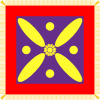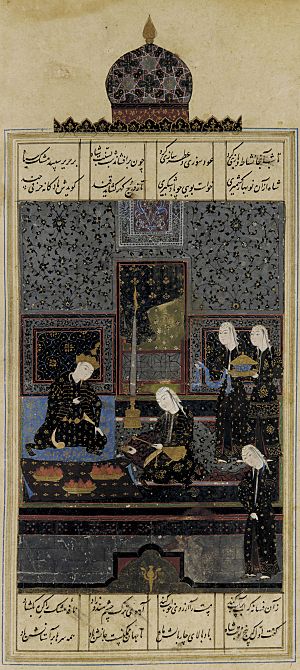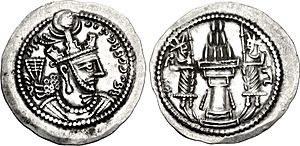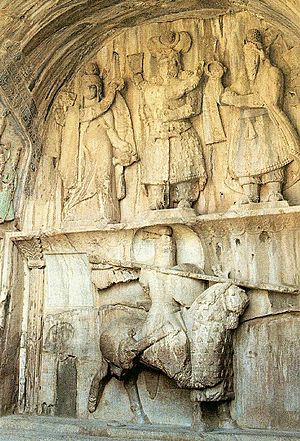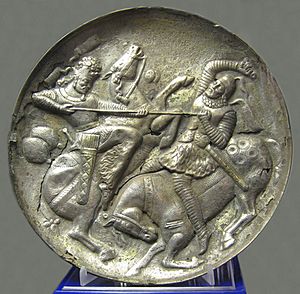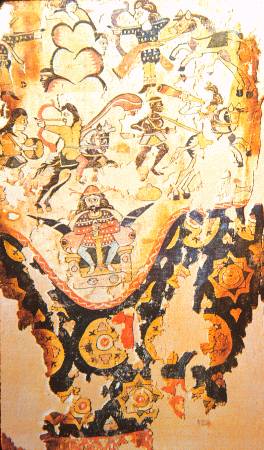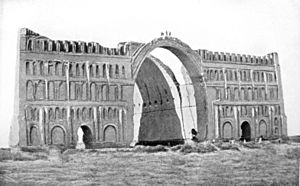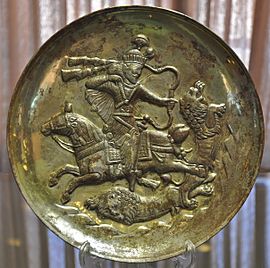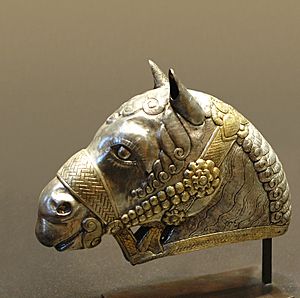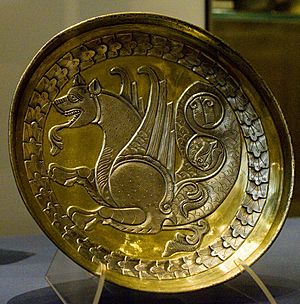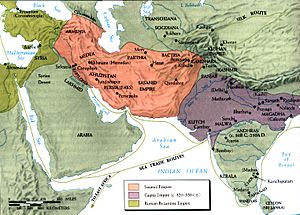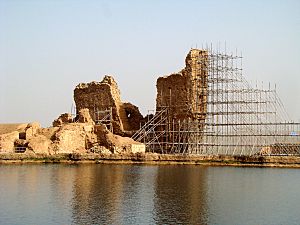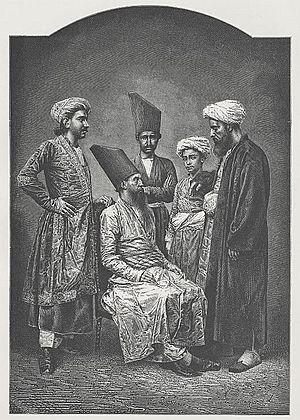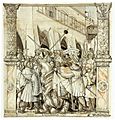Sasanian Empire facts for kids
Quick facts for kids
Empire of the Iranians
Ērānšahr
|
|||||||||||||||||||||||||||||
|---|---|---|---|---|---|---|---|---|---|---|---|---|---|---|---|---|---|---|---|---|---|---|---|---|---|---|---|---|---|
| 224–651 | |||||||||||||||||||||||||||||

The Sasanian Empire at its greatest extent c. 620, under Khosrow II
|
|||||||||||||||||||||||||||||
| Capital |
|
||||||||||||||||||||||||||||
| Common languages | Middle Persian (official) Other languages |
||||||||||||||||||||||||||||
| Religion |
|
||||||||||||||||||||||||||||
| Government | Feudal monarchy | ||||||||||||||||||||||||||||
| Shahanshah | |||||||||||||||||||||||||||||
|
• 224–241
|
Ardashir I (first) | ||||||||||||||||||||||||||||
|
• 632–651
|
Yazdegerd III (last) | ||||||||||||||||||||||||||||
| Historical era | Late Antiquity | ||||||||||||||||||||||||||||
| 28 April 224 | |||||||||||||||||||||||||||||
|
• The Iberian War
|
526–532 | ||||||||||||||||||||||||||||
|
• Climactic Roman–Persian War of 602–628
|
602–628 | ||||||||||||||||||||||||||||
|
• Civil war
|
628–632 | ||||||||||||||||||||||||||||
| 633–651 | |||||||||||||||||||||||||||||
|
• Empire collapses
|
651 | ||||||||||||||||||||||||||||
| Area | |||||||||||||||||||||||||||||
| 550 | 3,500,000 km2 (1,400,000 sq mi) | ||||||||||||||||||||||||||||
|
|||||||||||||||||||||||||||||
The Sasanian Empire, also called Eranshahr (meaning "Land of the Iranians"), was the last big Iranian empire before the Muslim conquests in the 600s AD. It was named after the Sasan family and lasted for over 400 years, from 224 to 651 AD. This makes it the longest-lasting Persian empire. The Sasanian Empire took over from the Parthian Empire. It made the Persians a strong power again, just like their rival, the Roman Empire.
The empire was started by Ardashir I. He became powerful when the Parthian Empire was weak. After winning a big battle in 224 AD, he started the Sasanian family rule. He wanted to bring back the glory of the old Achaemenid Empire. At its largest, the Sasanian Empire included all of modern-day Iran and Iraq. It also stretched from the Mediterranean Sea to parts of Pakistan, and from southern Arabia to the Caucasus and Central Asia.
The Sasanian period was a golden age for Iranian history and culture. They had a complex government and made Zoroastrianism their official religion. They built amazing monuments and supported learning. Their culture influenced Europe, Africa, China, and India. Persian culture also became very important for Islamic culture later on.
Contents
- Understanding the Sasanian Empire's Name
- A Look at Sasanian History
- How the Sasanian Government Worked
- Relationships with Other Countries
- Sasanian Society and Culture
- Sasanian Economy
- Religion in the Sasanian Empire
- Languages Spoken in the Sasanian Empire
- Legacy of the Sasanian Empire
- Key Dates in Sasanian History
- Images for kids
- See also
Understanding the Sasanian Empire's Name
The empire was officially known as the Empire of Iranians. In their language, Middle Persian, this was ērānšahr. The term first appeared in an inscription by King Shapur I. He said, "I am the ruler of the Empire of Iranians."
Historians often call it the Sasanian Empire. This is because the ruling family was named after Sasan. It is also sometimes called the Neo-Persian Empire. This is because it was the second Iranian empire to rise from the region of Pars, after the Achaemenid Empire.
A Look at Sasanian History
The Sasanian Empire had a long and exciting history. It started with a new ruler and grew very powerful. Then, it faced many challenges and eventually fell.
How the Sasanian Empire Began (205–310 AD)
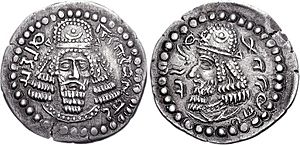
The Sasanian Empire began in a city called Estakhr. It was founded by Ardashir I. His father, Papak, was a local ruler. Papak and his son Shapur expanded their power.
After Papak died, Ardashir fought his older brother Shapur for power. Shapur died, and Ardashir became the ruler of Pars by 208 AD. He then moved his capital to Ardashir-Khwarrah, a city easy to defend.
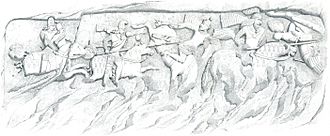
Ardashir quickly expanded his lands. He took control of nearby provinces. The Parthian king, Artabanus IV, tried to stop him. But Ardashir won the battles, and Artabanus IV died.
In 224 AD, Ardashir was crowned in Ctesiphon. He took the title shahanshah, meaning "King of Kings." This ended the 400-year-old Parthian Empire.
Ardashir I continued to expand his new empire. He conquered lands to the east and northwest. He also added Bahrain and Mosul. Later, his son Shapur I continued the expansion.

Shapur I fought many wars against the Romans. He captured some Roman cities. In one famous battle, he captured the Roman emperor Valerian. Shapur celebrated this victory with impressive rock carvings.
Shapur also built many cities and a dam bridge. He was friendly towards Manichaeism and Jews. However, later kings like Bahram I and Bahram II changed this policy. They persecuted Mani and his followers.
The Sasanian capital, Ctesiphon, was attacked by the Romans. Most of Armenia was given to the Romans. Later, Narseh fought the Romans again but was defeated. Persia had to give up some land to Rome.
The First Golden Age (309–379 AD)
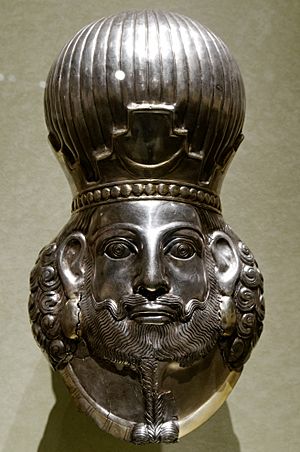
After Hormizd II died, Arab tribes attacked the empire's western cities. Hormizd II's sons were killed or imprisoned. The throne went to Shapur II, who was still unborn. His mother and nobles ruled until he grew up.
Shapur II became a strong and effective ruler. He first defeated the Arabs in the south. Then, he fought the Romans in the west. He won many battles but could not capture key cities.
Nomadic tribes from the east then threatened the empire. Shapur marched east and defeated them. He took control of large areas in what is now Afghanistan and Pakistan. Sasanian art and culture spread far into Asia.
Shapur II continued fighting the Romans. He won back some cities. The Roman emperor Julian attacked Persia but was killed. His successor, Jovian, had to give back all the lands Persia had lost in 298 AD.
Shapur II had a strict religious policy. He completed the collection of the Avesta, the holy texts of Zoroastrianism. He punished heresy and persecuted Christians. But he was friendly towards Jews. By the time he died, the Persian Empire was very strong.
A Time of Change (379–498 AD)
After Shapur II died, there was a peaceful time with the Romans. The Sasanian Empire had some weaker rulers. But the government system Shapur II created kept the empire strong.
Kings like Ardashir II, Shapur III, and Bahram IV ruled. Armenia was divided between the Roman and Sasanian empires. The Sasanians took back control of most of Armenia.
Yazdegerd I (399–421 AD) was a tolerant ruler. He stopped the persecution of Christians. He even took care of the young Roman emperor Theodosius II. Yazdegerd also married a Jewish princess.
His son, Bahram V (421–438 AD), became a famous Sasanian king. He is the hero of many myths. He defeated the nomadic Hephthalites in the east. He also made Armenia a province of the empire.
Bahram V was known for his bravery and love of hunting. He was called Bahram-e Gur, meaning "Bahram the Onager." He represented a golden age for the empire. During his rule, great Persian literature and music were created. Sports like polo became popular.
Bahram V's son, Yazdegerd II (438–457 AD), was stricter. He persecuted Christians and, to a lesser extent, Jews. He fought the Byzantine Empire and the Kidarites. The Armenians, however, kept their Christian faith.
The Hephthalites attacked Iran again at the end of the 400s. They defeated and killed King Peroz I (457–484 AD). This caused instability in the kingdom. Peroz's brother, Balash, became king.
Balash (484–488 AD) was a kind ruler. He reduced taxes and was good to Christians. But the nobles and priests did not like him. They removed him from power.
Kavad I (488–531 AD), Peroz's son, became the new king. He was energetic and wanted to make reforms. He supported a group called the Mazdakites, who wanted the rich to share their wealth. These reforms led to him being removed and imprisoned.
His younger brother, Jamasp (496–498 AD), became king. Jamasp was also a good king. He lowered taxes to help the poor. But Kavad escaped and returned with a large army. Jamasp stepped down, and Kavad became king again.
The Second Golden Age (498–622 AD)
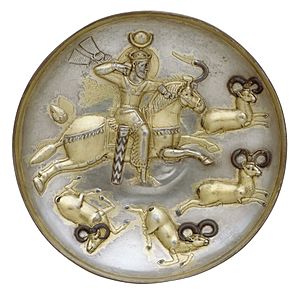
Kavad I's second reign began a new golden age. He fought against the Romans with the help of the Hephthalites. He captured some cities but also lost some. He made a peace treaty with the Romans.
Kavad I brought order back to the empire. He started new cities and improved the tax system. After him, his son Khosrow I (531–579 AD) became king. Khosrow I is considered one of the greatest Sasanian rulers.
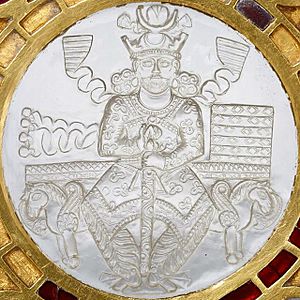
Khosrow I made important changes to the government. He created a fair tax system. He also built a new army of "knights" who were paid by the government. This made the army more loyal to the king.
Khosrow I broke a peace treaty with the Romans and invaded Syria. He captured Antioch and took money from other cities. He also gained control of Lazica. The war continued for many years.
Khosrow I also helped establish a base in South Arabia. This helped the Sasanians control trade with the east. His reign saw the rise of the dihqans, who were local landholders. He built many new buildings and forts. He was tolerant of most religions.
After Khosrow I, Hormizd IV (579–590 AD) became king. The war with the Byzantines continued. A general named Bahram Chobin rebelled against Hormizd. Hormizd was overthrown, and his son Khosrow II (590–628 AD) became king.
But Bahram Chobin defeated Khosrow II, forcing him to flee. Khosrow asked the Byzantine Emperor Maurice for help. He promised to give land to the Byzantines. With Byzantine help, Khosrow II defeated Bahram and got his throne back.
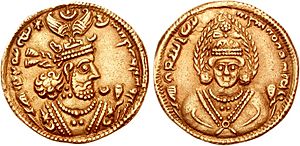
This peace allowed both empires to focus on other problems. Khosrow II dealt with raids from the Hephthalites in the east. Later, when Emperor Maurice was killed, Khosrow II used it as an excuse to invade the Byzantine Empire.
The Persians conquered many Byzantine territories, including Syria, Jerusalem, and Egypt. The Sasanian Empire almost reached the size of the old Achaemenid Empire. This was a time of great growth for Persian art and culture.
The Decline and Fall of the Empire (622–651 AD)
The long wars had exhausted the Persian army and treasury. Khosrow II taxed his people heavily to pay for the wars. Meanwhile, the Byzantine emperor Heraclius launched a strong counter-attack.

Between 622 and 627, Heraclius won many victories against the Persians. He even sacked a major Zoroastrian temple. In 626, Khosrow II tried to besiege the Byzantine capital, Constantinople, with allies. But the siege failed.
In 627, Heraclius invaded Mesopotamia. He defeated the Persian army and sacked Khosrow's palace. These defeats greatly weakened Khosrow's power. In early 628, his son Kavadh II overthrew and killed him.
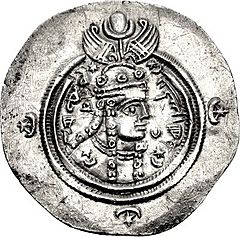
Kavadh II immediately ended the war and gave back all the captured lands. But he died within months. This led to chaos and civil war. Over four years, five different kings ruled. The empire became very weak.
In 632, Yazdegerd III, a grandson of Khosrow I, became king. In the same year, Arab tribes, newly united by Islam, began to invade Persian territory. The long wars had weakened both the Byzantines and the Persians.
The Sasanian Empire was also suffering from economic problems, high taxes, and internal conflicts. It could not put up a strong fight against the Arab armies. Yazdegerd was a young boy and could not unite the country.
In 637, a Muslim army defeated a large Persian force at the Battle of al-Qādisiyyah. They then captured Ctesiphon, the capital. Yazdegerd fled eastward. The Muslims took the empire's treasury.
Persian governors tried to fight back, but they lacked a strong leader. They were defeated at the Battle of Nihawānd. The Sasanian army was destroyed. The empire was helpless against the Arab invaders.
Yazdegerd fled further east to Khorasan. He was assassinated by a miller in 651 AD. His sons fled to China. Some nobles settled in Central Asia. They helped spread Persian culture and language there.
The Sasanian Empire fell quickly, in just five years. Most of its land became part of the Islamic caliphate. However, many Iranian cities resisted the invaders for a long time. People were not forced to convert to Islam at first. They paid a special tax to the Muslim state.
How the Sasanian Government Worked
The Sasanian Empire was a highly organized state. Its capital was Ctesiphon. The ruler was called the shahanshah, or "King of Kings." He was seen as the central leader and protector of the sacred fire, which was a symbol of their religion.
Sasanian queens were called Banbishnan banbishn (Queen of Queens). The empire was very centralized. They had a strong government system. A powerful group of officials helped the king rule. The head of this group was the wuzurg framadar, like a prime minister.
The Zoroastrian priests were also very powerful. The head priest, the mowbedan mowbed, had great influence. The Sasanian kings usually listened to their ministers.
The king's position was usually passed down in the family. But sometimes, nobles and priests chose a new ruler from the royal family.
The Sasanian nobility included old Parthian families and new Persian families. These noble families held important positions in the government. They often ruled border provinces, called marzban. These positions were often passed down through families.
Sasanian society had a strict social class system. This system was supported by Zoroastrianism, the state religion. Other religions were generally tolerated. The Sasanian emperors wanted to bring back old Persian traditions.
The Sasanian Military Power
The Sasanian army was very strong. It was created by Ardashir I. He brought back military ideas from the old Achaemenid Empire. He also used the Parthian cavalry style and new types of armor and siege weapons.
Priests and Warriors Working Together
The relationship between priests and warriors was very important. The idea of "Ērānshahr" (Land of Iranians) was supported by the priests. This bond helped the empire survive in its early days. Religion and state were seen as one. However, later on, disagreements between these groups weakened the empire.
Foot Soldiers (Infantry)
The main part of the Sasanian army was the Paygan, or infantry. They were often recruited from farmers. They guarded supplies, helped higher-ranking soldiers, and attacked city walls.
They used shields and spears. The Sasanian army also included soldiers from the Medes and Dailamites. Medes were good at throwing javelins and slings. Dailamites were known for their close-combat skills.
The Sasanian navy was important for controlling the Persian Gulf. It kept the gulf safe from pirates and other threats. However, many historians believe the navy was not very strong. The men serving in it were often prisoners. The navy's leader was called the nāvbed.
Horse Soldiers (Cavalry)
The Sasanian army had two types of heavy cavalry: Clibanarii and Cataphracts. These were elite noblemen trained from a young age. They were supported by light cavalry, foot soldiers, and archers. Mercenaries from other tribes also joined these units.
The Sasanians also used war elephants. They were experts at using elephants to support their cavalry.
Unlike the Parthians, the Sasanians developed advanced siege engines. These were useful for capturing cities. They also had good ways to defend their own cities. Sasanian heavy cavalry used lances and bows. Their armor was very heavy, covering almost their entire bodies.
Sasanian horsemen did not use stirrups. Instead, they had special saddles that helped them stay on the horse during battle. Maintaining a Sasanian knight was very expensive. They received land from the king in return for their service.
Relationships with Other Countries
The Sasanian Empire had many interactions with its neighbors. Some were peaceful, but many were wars.
Constant Wars with the Romans
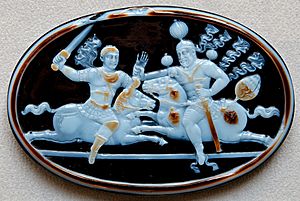
The Sasanians, like the Parthians before them, were often at war with the Roman Empire. For over 400 years, the Sasanian Empire was seen as one of the world's leading powers, alongside the Byzantine Empire (the Eastern Roman Empire).
Wars between the two empires became more frequent. The Sasanians also fought with other kingdoms and nomadic tribes. They were generally better at dealing with nomads than the Romans. They built forts to protect their borders.
The last major war with the Byzantines (602–628 AD) exhausted both empires. This made them weak when the Islamic Rashidun Caliphate suddenly appeared. The Muslim forces quickly conquered the entire Sasanian Empire. They also took many Byzantine territories.
To the east, the Sasanians faced the Kushan Empire and nomadic tribes like the White Huns. They built forts like Tus and cities like Nishapur to defend against attacks.
In the south, Arab tribes sometimes raided the empire. The Kingdom of Al-Hirah, a Sasanian vassal, acted as a buffer. When Khosrau II ended this kingdom, it made the Sasanians more vulnerable to Arab attacks later on.
In the north, the Khazars and Western Turkic Khaganate often attacked. The Sasanians built many forts in the Caucasus region, like the impressive walls in Derbent, Russia. These walls are still standing today.
On the eastern side of the Caspian Sea, the Sasanians built the Great Wall of Gorgan. This 200 km long wall protected the empire from northern peoples like the White Huns.
War with Axum (Yemen)
Around 522 AD, a group from Axum (modern-day Ethiopia) attacked the Himyarites in southern Arabia. The Himyarites asked the Sasanians for help. The Axumites then turned to the Byzantines.
Later, the Axumites sent another force and killed the Arab leader. They put an Axumite king in charge. In 531, Emperor Justinian of Byzantium suggested that the Axumites stop Persian trade with India.
But an Axumite general took control of Yemen and made it independent. After he died, one of his sons, Ma'd-Karib, asked Khosrow I for help. Khosrow I sent an army that captured the capital. Ma'd-Karib's son became king.
This allowed the Sasanians to control sea trade with the east. Later, southern Arabia became a Sasanian province.
Relations with China
The Sasanian Empire had strong ties with China. Persian ambassadors often traveled to China. Chinese records show many Sasanian embassies between 455 and 555 AD.
Trade by land and sea was important for both empires. Many Sasanian coins have been found in southern China. Sasanian kings even sent musicians and dancers to the Chinese court.
Both empires benefited from the Silk Road. They worked together to protect trade routes from nomadic tribes and bandits. They also formed alliances against common enemies like the Hephthalites.
After the Muslim Arabs invaded Iran, Peroz III, son of Yazdegerd III, fled to China. He and his son Narsieh were given high titles at the Chinese court. Chinese troops were even sent to help Peroz try to regain his throne.
Narsieh later became a commander of the Chinese imperial guards. His descendants lived in China as respected princes.
Relations with India
After conquering Iran, Shapur I extended his power to northwest India. The Kushans there had to accept his rule. Sasanian culture spread into Kushan territories. The Kushans were influenced by Sasanian ideas of kingship.
Cultural exchange also happened at a lower level. Persians imported an early form of chess from India. In return, Persians introduced backgammon to India.
During Khosrow I's reign, many Indian books were translated into Middle Persian. Some of these later influenced Islamic and Arabic literature. A famous example is the translation of the Indian Panchatantra by Borzuya. This book of fables later became known as Kalīlag ud Dimnag.
Sasanian Society and Culture
Sasanian society was very complex. It had different social groups. The Sasanians wanted a strong, centralized government. They were successful at building cities. Mesopotamia had a very high population density during this time.
The Sasanians founded and rebuilt many cities. They named some after themselves, like Veh-Ardashir. Many cities were populated by native people and Roman prisoners of war. These prisoners were skilled workers who helped build cities, bridges, and dams. This also helped spread Christianity in the empire.
There is less information about the nomadic people. They were called "Kurds" by the Sasanians. They often served in the Sasanian military.
The King of Kings (Shahanshah)
The shahanshah was the head of the Sasanian Empire. His health and well-being were very important. Sasanian coins from the 6th century show the moon and sun. This suggests the king was seen as the center of the world.
The king wore colorful clothes, makeup, and a heavy crown. His beard was decorated with gold. Early Sasanian kings believed they were from divine families.
When the king appeared in public, he was hidden behind a curtain. Guards kept people away from him. People had to bow down to him. The king's guards were from royal families. They were led by the hazarbed, who was in charge of the king's safety.
Social Classes
Sasanian society had four main social classes:
- Asronan (priests)
- Arteshtaran (warriors)
- Wastaryoshan (commoners)
- Hutukhshan (artisans)
The shahanshah ruled over all the nobles. Royal princes, local rulers, great landowners, and priests were a privileged group. This social system was quite strict.
Slavery in the Sasanian Empire
Mass slavery was not common in Iran. Sometimes, prisoners of war became semi-slaves. Their lives were often better than those of commoners. Debtors also sometimes worked as "slaves" in fire-temples.
Most slaves were household servants. They worked in private homes and fire-temples. Female slaves were common, and their masters had control over them. Slaves received wages and could have families. Harming a slave was a crime.
Masters could free their slaves, which was seen as a good deed. Slaves could also be freed if their master died.
Education and Learning
The capital city had a major school called the Grand School. It started with only 50 students. In less than 100 years, it grew to over 30,000 students.
Arts, Science, and Literature
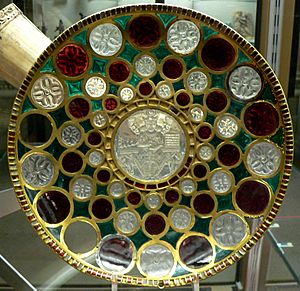
Sasanian kings supported learning and philosophy. Khosrau I had works by Plato and Aristotle translated. He also read them himself. Many historical records were written during his reign.
The Academy of Gundishapur, founded in the 400s, became a major center of learning. It attracted students and teachers from all over the world. Greek, Indian, Persian, and Syriac medical knowledge mixed there.
The Sasanian period was a high point for Iranian art. Much of what became known as Muslim culture, including architecture, came from Persian culture. Sasanian art influenced Central Asia, China, the Byzantine Empire, and even Europe.
Sasanian carvings and palace features were colored. Paintings also flourished. The prophet Mani was said to have founded a painting school. When a Sasanian king died, the best painter made his portrait for the royal collection.
Sasanian art also appeared in textiles. Silks, embroideries, carpets, and rugs were made with great skill. These fabrics were admired and copied across the world. The famous "Winter Carpet" of Khosrau Anushirvan was designed to look like spring.
Sasanian kings wore over 100 types of crowns. These crowns showed the culture, economy, and history of each period. They also showed the king's personality. Symbols like the moon, stars, eagle, and palm showed their religious beliefs.
The Sasanians saw themselves as the heirs of the Achaemenids. They wanted to bring back Persia's greatness. Their art combined traditional Persian styles with Greek influences.
Sasanian palaces showed the splendor of the kings. Examples include palaces at Firuzabad and Bishapur. These palaces had large, barrel-vaulted halls called iwans. The arch at Ctesiphon was huge, over 80 feet wide and 118 feet high.
Sasanian architects used massive brick walls decorated with stucco. They also used mosaics on floors, sometimes showing banqueting scenes. These mosaics might have been made by Roman prisoners.
Sasanian Economy
The Sasanian economy relied on farming. Khuzestan and Iraq were the most important farming regions. The Nahravan Canal is a great example of their irrigation systems. The mountains were used for lumber. The government taxed nomads and mountain dwellers.
Two main trade routes were used: the famous Silk Road in the north, and a less known route on the southern coast. Factories in Susa, Gundeshapur, and Shushtar were known for producing silk. The Sasanians were tolerant of farmers, allowing them to store food in case of famine.
Industry and Trade
Persian industry grew from home-based to urban factories. There were many guilds. Good roads and bridges helped trade. Harbors were built in the Persian Gulf for trade with India. Sasanian merchants became very active in Indian Ocean trade.
Khosrau I expanded the trade network. The Sasanian state controlled much of the trade, especially luxury goods. They built many ports, inns for travelers (caravanserais), and bridges. Persians dominated international trade in the Indian Ocean, Central Asia, and South Russia.
Main exports included silk, wool and gold textiles, carpets, hides, leather, and pearls. They also re-exported goods from China (paper, silk) and India (spices) to Europe.
Metallurgy (metal production) also increased. Iran became known as the "armory of Asia." Most mining centers were on the edges of the empire.
Religion in the Sasanian Empire
Under the Parthians, Zoroastrianism had many local variations. Greek religious ideas had mixed with it. But under the Sasanians, a more traditional Zoroastrianism was revived.
Sasanian Zoroastrianism developed clear differences from the old texts. The Sasanian kings' religious policies led to new religious movements, like those started by Mani and Mazdak.
The kings had different approaches to religion. Shapur I tolerated many religions. But later kings like Bahram II sometimes suppressed minorities. Shapur II tolerated most groups except Christians, whom he persecuted after the Roman emperor Constantine converted.
Tansar and the New Dynasty
From the start of Sasanian rule in 224 AD, Zoroastrianism played a key role. It helped legitimize the new state. Ardashir I sought help from Tansar, a high priest. Tansar wrote letters to local kings, asking them to accept Ardashir.
Tansar argued that the old ways were not always good. He said Ardashir was better than previous rulers. He also criticized the Parthians for not following traditional Zoroastrianism. He claimed Zoroastrianism needed to be "restored" after Alexander's invasion.
Tansar helped create a single Zoroastrian church. He also approved a single set of Avestan texts.
The Influence of Kartir
Kartir was a very powerful priest. He served several Sasanian kings. He worked to establish a strict Zoroastrian faith across the empire. He was so influential that he had his own rock inscriptions.
Under Shapur I, Kartir became the "absolute authority" over priests. He made sure all regional Zoroastrian priests reported to the Persian ones. He also destroyed temples with images and idols, replacing them with sacred fires. Kartir also encouraged khvedodah (marriage within the family). He persecuted non-Zoroastrians and had the prophet Mani executed.
Zoroastrian Calendar Changes
The Persians knew about the Egyptian calendar. The traditional Zoroastrian calendar had 12 months of 30 days. Under Ardashir I, 5 extra days were added to make it more accurate. These were called the Gatha days.
This caused confusion because important festivals shifted. People continued to celebrate on old dates. The Sasanians tried to enforce new dates. Later, they made a compromise, linking parallel celebrations.
Nowruz, the Persian New Year, had shifted from spring to autumn. This was corrected during Kavad I's reign. Nowruz was moved back to spring, linking it with resurrection.
The Three Great Fires
During the Sasanian era, three "Great Fires" became very important. The Adur Farnbag in Pars was linked with priests. The Adur Gushnasp in Media was linked with warriors. The Adur Burzen-Mehr in Parthia was linked with farmers.
The Adur Gushnasp became a pilgrimage site for new kings after their coronation. These three fires became central places for Zoroastrian pilgrimage.
Changes in Language and Images
Early Sasanians removed cult images from temples. They replaced them with sacred fires. This policy sometimes extended to non-Iranian regions. However, they still used images to represent Zoroastrian gods.
Early royal inscriptions used Parthian, Middle Persian, and Greek. But by Narseh's reign, Greek was no longer used. Parthian also disappeared as an official language. This was probably to make Persian the main language.
Zoroastrian Literature and Texts
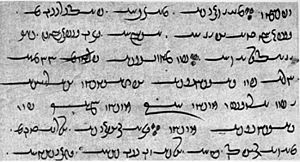
Some scholars believe the yasna service was made longer during the Sasanian era. A longer service called the Visperad was also developed for holy days.
The Middle Persian Zand and other Zoroastrian texts were written down for the first time during this period. Many were original Sasanian works, like the Bundahishn (mythical Creation story). Older works were also translated.
The Sasanians created the Avestan alphabet. This allowed them to accurately write down the Avesta. The Avesta was then organized into 21 sections.
An important text, the Khwaday-Namag (Book of Kings), was written. This text became the basis for Ferdowsi's later Shahnameh.
Christianity in the Empire
Christians in the Sasanian Empire mostly belonged to the Nestorian Church and the Jacobite Church. These churches were different from Roman Christian churches. Their language was Syriac, not Greek.
Sasanian rulers wanted these churches to break ties with Rome. This was because the Sasanian Empire was often at war with the Roman Empire.
Christianity was recognized by Yazdegerd I in 409 AD. A major break with mainstream Christianity happened in 431 AD. The Council of Ephesus condemned Nestorius. The Sasanian church disagreed with this. Many of Nestorius's followers fled to the Sasanian Empire.
Persian emperors used this to strengthen Nestorianism. They replaced pro-Roman clergy with Nestorians. This ensured Christians were loyal to Persia, not Rome.
Most Christians lived in Mesopotamia. But there were also communities in Armenia, Lazica, and Iberia. Armenia became the first Christian state in 301 AD.
Other Religions in the Empire
Recent discoveries show Buddhist, Hindu, and Jewish sites in the empire. Buddhism and Hinduism were present in the eastern territories.
A large Jewish community thrived under Sasanian rule. They had centers in Isfahan, Babylon, and Khorasan. They had their own leaders. Jews faced only occasional persecution. They had more religious freedom than other minorities.
Shapur I was friendly with Jews. His friendship with Rabbi Shmuel brought many benefits. Shapur II, whose mother was Jewish, also had a good relationship with a rabbi. This helped relax harsh laws against Jews.
In the eastern part of the empire, Buddhist places of worship were active. Buddhism became more popular there.
Languages Spoken in the Sasanian Empire
Official Languages
Early Sasanian inscriptions used Middle Persian, Koine Greek, and Parthian. But by Narseh's reign, Greek was no longer used. This might be because Greek was common among the Romans, their rivals.
Parthian also stopped being an official language. However, it was still spoken in the eastern part of the empire. Many Parthian nobles who joined Sasanian service still spoke Parthian.
Aramaic was widely used in the Sasanian Empire. It provided the writing system for Middle Persian and other languages.
Regional Languages
Middle Persian was the native language of the Sasanians. But it was spoken by a minority in the vast empire. It was mainly spoken in Pars and surrounding regions. There were also different Persian dialects.
Other languages were spoken in various regions:
- In Azerbaijan, an old language called Adhari was spoken.
- In Gilan and Mazandaran, Pre-Daylamite and Proto-Caspian languages were spoken.
- In the Caucasus, Old Georgian, Kartvelian languages, Old Armenian, and Caucasian Albanian were spoken.
- In Khuzestan, Persian and Eastern Middle Aramaic were spoken.
- In Meshan, Aramaic and Arabic were spoken. Indians and Malays were also deported there.
- In Asoristan, most people were Aramaic-speaking Nestorian Christians.
- In Khorasan, Parthian and other Iranian dialects were spoken.
- Further east, Sogdian, Bactrian, and Khwarazmian were spoken.
- In Sakastan, a Southwestern Iranian language was spoken.
- In Kirman, an Iranian group similar to Persians lived.
- In major cities like Gundeshapur and Ctesiphon, Latin, Greek, and Syriac were spoken by Roman prisoners.
- In Yemen, Himyaritic and Sabaean languages were spoken.
Legacy of the Sasanian Empire
The Sasanian Empire's influence continued long after its fall. It had a "Persian renaissance" that greatly shaped the civilization of early Islam. In modern Iran and surrounding regions, the Sasanian period is seen as a high point of Iranian culture.
Influence in Europe
Sasanian culture and military ideas influenced Roman civilization. The Roman army's structure was affected by Persian warfare methods. Roman emperors copied Sasanian royal ceremonies. These ceremonies then influenced medieval and modern European courts. Even European diplomacy is said to have roots in Sasanian-Roman relations.
Impact on Jewish History
Important developments in Jewish history happened during the Sasanian Empire. The Babylonian Talmud was written there between the 3rd and 6th centuries. Major Jewish learning centers were established in Sura and Pumbedita.
Some members of the royal family, like Queen Ifra Hormizd and Queen Shushandukht (Yazdegerd I's Jewish wife), helped create good relations between Jews and the government.
Influence in India
After the Sasanian Empire fell, Islam slowly replaced Zoroastrianism in Iran. Many Zoroastrians left to escape persecution. One group settled in Gujarat, India. There, they could practice their customs and faith freely. Their descendants, called Parsees, played a significant role in India's development. Today, there are over 70,000 Zoroastrians in India.
Zoroastrians still use a version of the religious calendar created under the Sasanians. That calendar still counts the years since Yazdegerd III became king in 632 AD.
Key Dates in Sasanian History
- 224–241 AD: Reign of Ardashir I.
- 224: The Parthian Empire is overthrown.
- 229–232: War with Rome.
- Zoroastrianism becomes the official religion.
- 241–271 AD: Reign of Shapur I "the Great."
- 241–244: War with Rome.
- 252–261: Another war with Rome. Persia wins a big victory at Edessa and captures Roman emperor Valerian.
- 271–301 AD: A time of struggles for the throne.
- 296–298 AD: War with Rome. Persia gives up five provinces to Rome.
- 309–379 AD: Reign of Shapur II "the Great."
- 325: Shapur II defeats many Arab tribes.
- 337–350: First war with Rome.
- 359–363: Second war with Rome. Rome gives up many territories to Persia.
- 387 AD: Armenia is divided between Roman and Persian control.
- 399–420 AD: Reign of Yazdegerd I "the Sinner."
- 410: The Church of the East is officially recognized. Christians can worship openly.
- 416–420: Persecution of Christians begins again.
- 420–438 AD: Reign of Bahram V.
- 421–422: War with Rome.
- 428: Persian Armenia becomes a Sasanian province.
- 438–457 AD: Reign of Yazdegerd II.
- 440: War with the Byzantine Empire.
- 449–451: Armenian revolt. The Battle of Avarayr is fought against Christian Armenian rebels.
- 484 AD: Peroz I is defeated and killed by Hephthalites. The Nvarsak Treaty allows Armenians to practice Christianity freely.
- 502–506 AD: War with the Byzantine Empire.
- 526–532 AD: War with the Byzantine Empire. A "Treaty of Eternal Peace" is signed.
- 531–579 AD: Reign of Khosrau I, also known as Anushirvan.
- 572–591 AD: War with the Byzantine Empire.
- 590 AD: Khosrau II is overthrown by Bahram Chobin but regains the throne with Byzantine help.
- 603–628 AD: Long war with the Byzantine Empire. Persia conquers many Byzantine lands.
- 610 AD: Arabs defeat a Sasanian army at Dhu-Qar.
- 626 AD: Unsuccessful siege of Constantinople by Persian, Avar, and Slavic forces.
- 627 AD: Byzantine Emperor Heraclius invades Persia. Persians are defeated at the Battle of Nineveh.
- 628 AD: Kavadh II overthrows and kills Khosrau II. He ends the war.
- 628–632 AD: A period of civil war and many short-reigning rulers.
- 632–644 AD: Reign of Yazdegerd III.
- 636 AD: Major Sasanian defeat at the Battle of al-Qādisiyyah against Muslim Arabs.
- 641 AD: Muslims defeat the Sasanian army at the Battle of Nihawānd.
- 651 AD: Yazdegerd III is killed in Merv, ending the Sasanian dynasty.
Images for kids
-
Early Alchon Huns coin based on the coin design of Shapur II.
-
The Humiliation of Valerian by Shapur by Hans Holbein the Younger (1521).
-
Rock relief of Ardashir I receiving the ring of kingship from the Zoroastrian god Ahura Mazda.
-
The spread of Manichaeism (300–500 AD).
See also
 In Spanish: Imperio sasánida para niños
In Spanish: Imperio sasánida para niños


